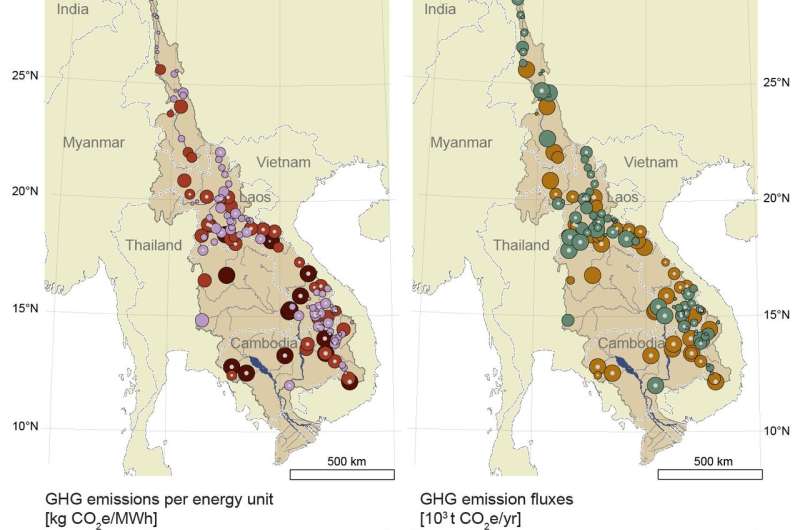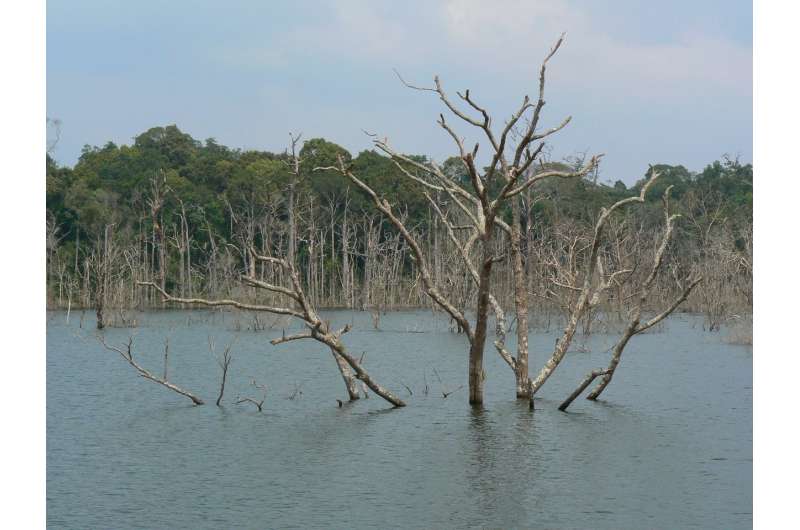Fig. 1: Estimated greenhouse gas emissions and power densities of 141 existing and planned reservoirs in the Mekong River Basin. CDM stands for Clean Development Mechanism of United Nation's Kyoto Protocol for implementing emission-reduction projects. Projects with power densities above 4W/m2 are eligible for CDM. Credit: Aalto University
Hydropower is commonly considered as a clean energy source to fuel Southeast Asian economic growth. A recent study published in Environmental Research Letters finds that hydropower in the Mekong River Basin, the largest river in Southeast Asia, might not always be climate friendly. The median greenhouse gas (GHG) emission of hydropower was estimated to be 26 kg CO2e/MWh over 100-year lifetime, which is within the range of other renewable energy sources (<190 kg CO2e/MWh). The variation between the individual hydropower projects was, however, large: nearly 20% of the hydropower reservoirs had higher emissions than other renewable energy sources and in several cases the emissions equalled those from fossil fuel energy sources ( greater than 380 kg CO2e/MWh). The study concludes that hydropower in the Mekong cannot be considered categorically as a clean energy source; instead, the emissions should be evaluated case-by-case together with other social and environmental impacts.
The Mekong River is a global hotspot for hydropower development. The economy in the region is growing rapidly and hydropower is broadly seen as a viable source for satisfying growing energy demands. However, the extent of hydropower development has raised concerns on ecological and social sustainability, particularly in the case of rich inland fisheries, on which millions depend for livelihoods and food. However, the potential climate impacts of the hydropower are insufficiently studied, although case studies from other tropical regions show that hydropower emissions cannot be neglected. The emissions originate mainly from degradation of organic material in the reservoir but also from dam construction.
In the Mekong Basin, emission measurements exist only from a few reservoirs, and the study led by Aalto University, Finland, is the first one to estimate the emissions of the entire hydropower development in the basin. The study estimated emissions of 64 existing and 77 planned hydropower reservoirs using statistical models that are based on global emission measurements. The focus was on gross emissions of CO2 and CH4 through the reservoirs water surface. The results are reported as CO2 equivalents (CO2e) that combines the CO2 and CH4 emissions.
Fig. 2: Reservoir of Nam Theun 2 hydropower project in Lao PDR, which is one of the few reservoirs with GHG emission measurements in the Mekong Region. The reservoir has surface area of 450 km2 and the power station has power generating capacity of 1075 MW. Credit: Aalto University
"The hydropower-related emissions started in the Mekong in mid-1960's when the first large reservoir was built in Thailand, and the emissions increased considerably in early 2000's when hydropower development became more intensive. Currently the emissions are estimated to be around 15 million tonnes of CO2e per year, which is more than total emissions of all sectors in Lao PDR in year 2013", says Dr. Timo Räsänen who led the study. The GHG emissions are expected to increase when more hydropower is built. However, if construction of new reservoirs is halted, the emissions will decline slowly in time.
"Highest emissions were generally found in hydropower projects that had large reservoirs compared to the electricity generating capacity and were located in warm sub-tropical areas. These findings suggest that the emissions of future hydropower projects can be reduced by designing and choosing the location appropriately", summarises Assistant Professor Matti Kummu. In addition, emissions can be mitigated by carefully removing the vegetation from the reservoir area before filling of the reservoir, and by minimising the amount of organic material entering the reservoir from the catchment.
The study calls for further research on GHG emissions of hydropower and improved inclusion of climate impacts in strategic environmental assessments (SEA) of hydropower in the Mekong to help to exclude most harmful projects. The results of the study are tentative and more extensive measurement and modelling campaigns are urgently needed to improve the accuracy of the emissions estimates.
More information: Timo A Räsänen et al. Greenhouse gas emissions of hydropower in the Mekong River Basin, Environmental Research Letters (2018). DOI: 10.1088/1748-9326/aaa817
Journal information: Environmental Research Letters
Provided by Aalto University
























